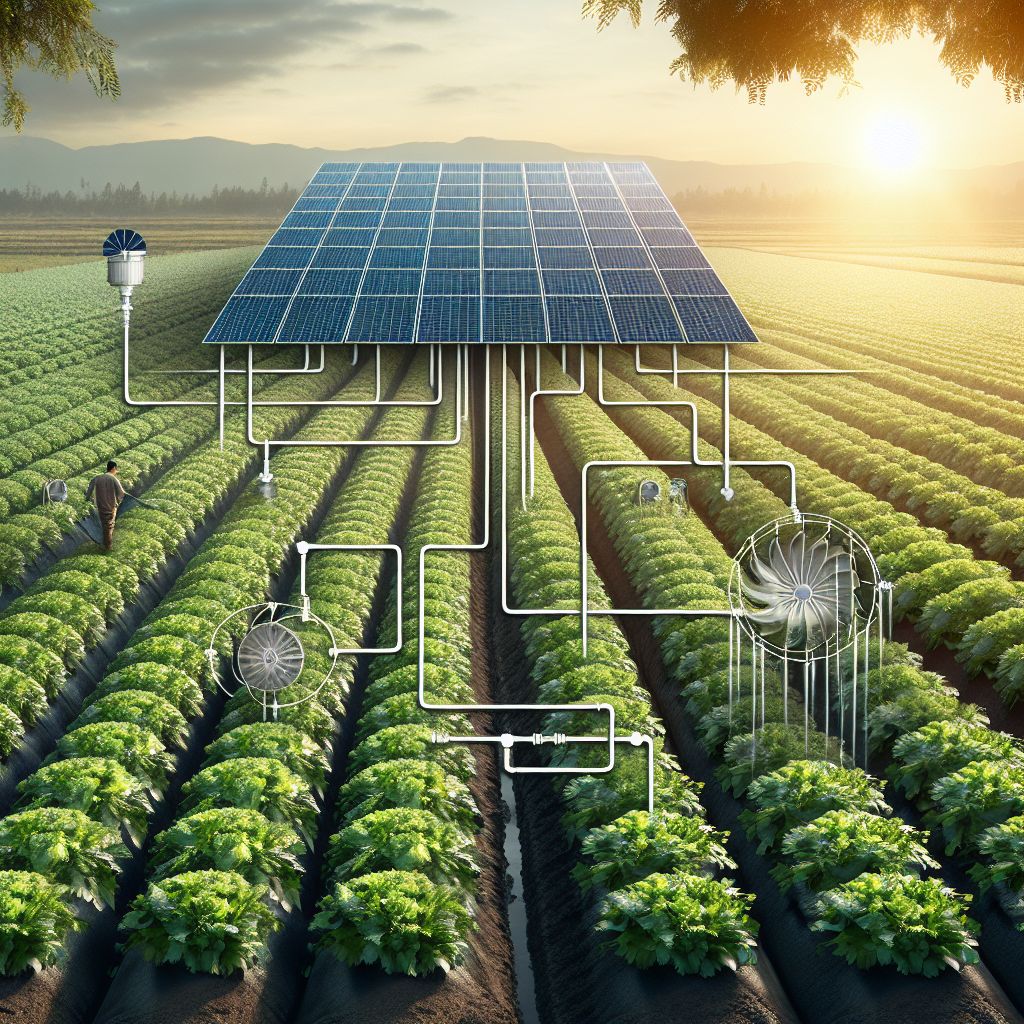
Key Takeaways
Watering crops like celery is sustainable and cost-effective with solar-powered irrigation.
Drip irrigation is the most efficient among several irrigation systems suitable for celery.
Monocrystalline solar panels are highly efficient and perfect for use with irrigation systems.
Switching to solar irrigation can result in significant long-term savings and environmental benefits.
Choosing the right combination of solar panels and irrigation systems is crucial for maximizing efficiency.
Why You Should Use Solar Panels with an Irrigation System
Consider this: the sun is a powerful energy source, and it’s just up there, shining down on us for free. So why not use that energy to grow our crops? By combining solar panels with an irrigation system, we can create a cycle that’s not just self-sustaining but also kind to our planet. This isn’t just a nice idea; it’s a smart move for any farmer looking to cut costs and go green.
Getting to Know Solar Energy: A Farmer’s Guide
Let’s start from the beginning. Solar panels transform sunlight into electricity, which you can then use to run your irrigation system. It’s like having a personal power plant right on your farm. And the best part? After you’ve installed your solar panels, the energy they generate is absolutely free. That’s right, you can say goodbye to expensive electricity bills just to keep your crops irrigated.
The Advantages of Solar-Powered Irrigation in Agriculture
Not only does solar-powered irrigation save you money, but it’s also a great way to help the planet. You’re using the power of the sun instead of burning fossil fuels, which reduces air pollution and your carbon footprint. And since solar panels need very little upkeep, you can just set them up and forget about them while you concentrate on growing the best celery possible.
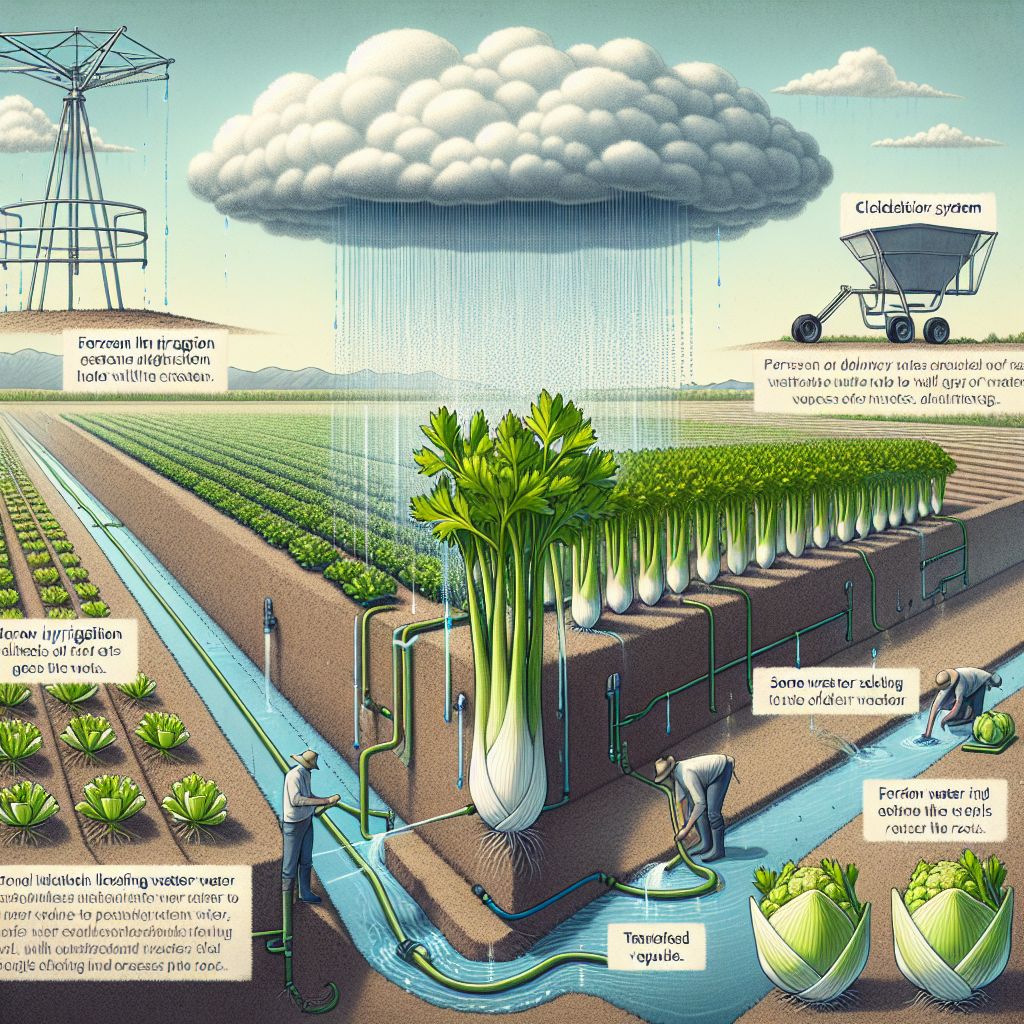
Various Irrigation Methods for Celery Farming
While celery requires a significant amount of water, it’s also crucial to conserve this vital resource. This is where a suitable irrigation system comes into play. You should aim to provide your celery with the perfect amount of water, avoiding any unnecessary runoff or evaporation. We’ll look at the systems that can assist you in achieving this goal.
Drip Irrigation: The Water Bottle for Celery
Think of drip irrigation like a personal water bottle for your celery. It delivers water directly to the roots of your celery, right where it’s needed most. This means less water is lost to evaporation, and you’re not watering the weeds. It’s efficient, effective, and perfect for keeping your celery hydrated without any waste.
Sprinkler Systems: Creating Rain to Cover Large Areas
Sprinkler systems are like having a personal rain cloud. They are perfect for covering large areas and can be timed to water your celery when you’re not around. Just remember that some water may evaporate before it hits the ground on hot days.
Furrow Irrigation: Traditional Methods with a Twist
Furrow irrigation is a traditional method of irrigation that has been used for centuries to water celery crops. It is a relatively simple and inexpensive method, but it does require some skill and experience to get it right.
Furrow irrigation is a surface irrigation method that involves flooding the furrows between rows of crops with water. The water is then allowed to soak into the soil and reach the roots of the plants. The furrows are typically 6-12 inches deep and are spaced 12-18 inches apart.
Here is a table showing the pros and cons of different irrigation systems a farmer can use on a farm:
|
Irrigation System |
Pros |
Cons |
|---|---|---|
|
Drip Irrigation |
– High water efficiency (90%+). 1 |
– High initial cost. 4 |
|
Sprinkler Irrigation |
– Relatively inexpensive to install. 5 |
– Lower efficiency than drip (60-80%). 1 |
|
Furrow/Surface Irrigation |
– Very low efficiency (50-60%). 1 |
The choice of irrigation system depends on factors like crop type, terrain, water availability, labor costs, and budget. Drip irrigation is generally the most water-efficient but has higher upfront and maintenance costs, while furrow irrigation is inexpensive but highly inefficient in water use. 1, 2, 3, 4, 5
Optimal Irrigation System for Celery Cultivation
When it comes to celery cultivation, an irrigation system that maintains a steady level of moisture without over-saturating the soil is optimal. Celery plants flourish in soil that stays uniformly moist, as both drought and waterlogging can result in subpar crop quality. As such, drip irrigation emerges as the most efficient method for celery farming. It supplies water right at the base of the celery plants, minimizing water wastage and inhibiting the propagation of diseases that thrive in damp foliage conditions.
By tailoring drip irrigation systems to the unique layout of your farm and the specific needs of your celery crop, you can use adjustable emitters to control the amount of water delivered to each plant. This ensures that each stalk of celery receives the perfect amount of hydration. Not only does this system save water, but it also saves time, freeing you up to focus on other tasks around the farm.
Furthermore, when combined with mulching methods, drip irrigation can save even more water and control weed growth, making a better environment for your celery plants to thrive. The decision is straightforward: for accuracy, effectiveness, and sustainability, drip irrigation is the best choice for celery farming.
Opt for a drip irrigation system to accurately deliver water to the roots of your celery plants.
Design the system to fit the layout of your farm and the specific requirements of your celery crop.
Use mulching in combination with your irrigation system to save more water and keep weeds at bay.
Adjust the emitters as needed to maintain even moisture levels and avoid waterlogging.
Now that we learned about irrigation systems, let’s take a look at solar panels
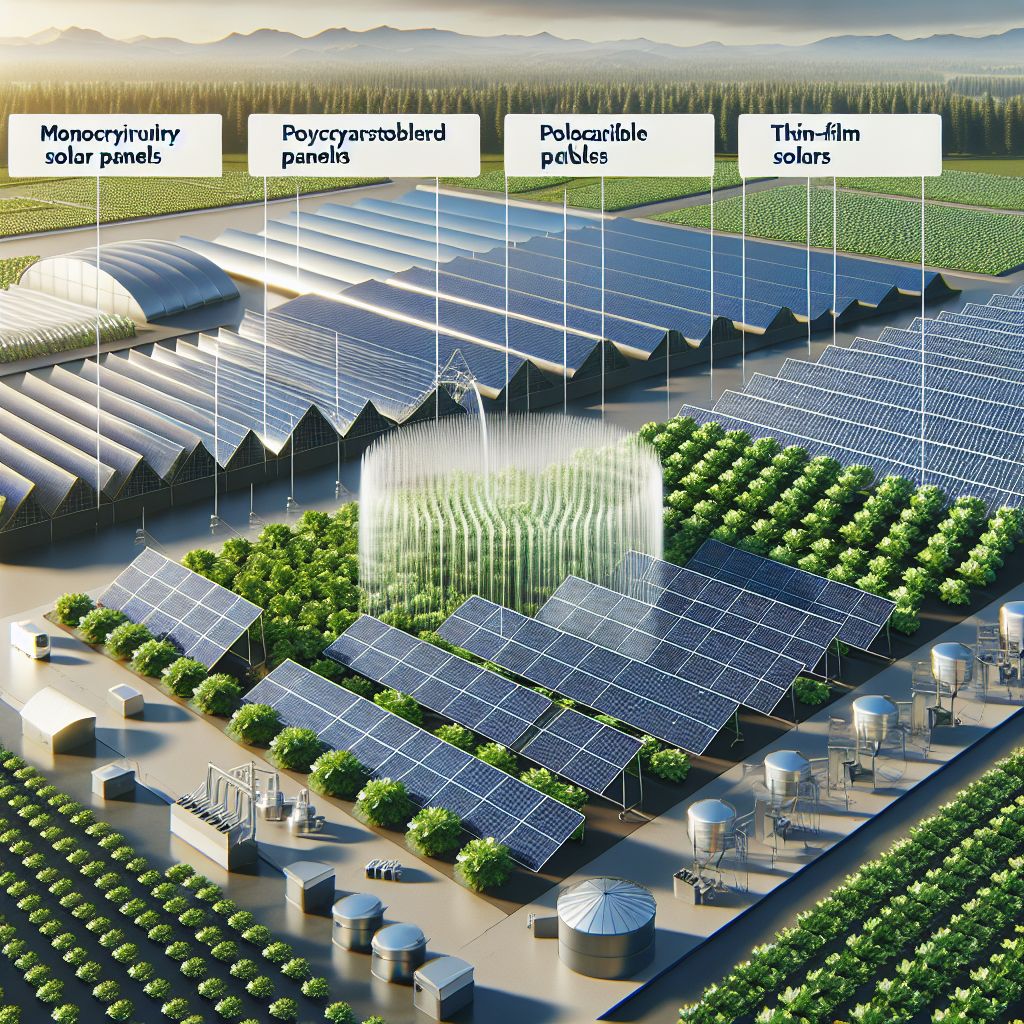
Choosing the Right Solar Panel for Your Celery Farm’s Irrigation System
When selecting the ideal solar panel for your irrigation system, factors such as efficiency, durability, and the unique energy demands of your farm should be taken into account. Given that celery requires regular watering, you’ll need a solar panel that can consistently power your irrigation system throughout the growing season.
Assessing Solar Panel Efficiency and Suitability with Irrigation Tools
If you want to maximize the benefits of your solar-powered irrigation system, first estimate the overall energy usage of your irrigation equipment. This encompasses the pump, all sensors, timers, and other related gear. From this data, you can figure out the required capacity of your solar panel array to guarantee it satisfies your energy demands even during overcast weather.
Secondly, look at the efficiency rating of the solar panel. The higher the efficiency, the more energy it will produce per square foot, which is important if you don’t have much space for installation. Also, check to see if the solar panels are compatible with your current irrigation equipment. Some systems may need a certain voltage or power setup, so it’s important to make sure the panels fit the specifications of your equipment.
Monocrystalline Panels: Where Efficiency and Longevity Come Together
Monocrystalline solar panels are typically the go-to for farming purposes because they’re highly efficient and have a long lifespan. These panels convert more sunlight into electricity than other types, which means you’ll need fewer panels to meet your energy needs. They also take up less space, which is a huge plus if your farm doesn’t have a lot of room for solar arrays.
Polycrystalline Panels: Economical and Dependable
Polycrystalline solar panels are a more wallet-friendly choice that still offer dependable service. Even though they’re not as efficient as monocrystalline panels, they can still provide enough power for your irrigation requirements, particularly if you have more space to house a bigger array.
Thin-Film Solar Panels: Easy to Install
Thin-film solar panels are light and bendable, which makes them simple to install on many types of surfaces. They’re not as efficient as mono and polycrystalline panels, but their flexibility can be a big plus, especially on farms with unusual or limited spaces for installation. For more details on how solar panels can enhance farm efficiency, check out this setup guide for solar panels on farms.
Here is a table showing the pros and cons of using different types of solar panels with an irrigation system on a farm:
|
Panel Type |
Pros |
Cons |
|---|---|---|
|
Monocrystalline Panels |
– High efficiency (15-22%), producing more power per square foot. 1, 2, 4 | |
|
Polycrystalline Panels |
– Lower upfront cost than monocrystalline. 1, 2 |
– Lower efficiency and shorter lifespan than monocrystalline. 2, 4 |
|
Thin-Film Solar Panels |
– Lowest upfront cost. 1, 2 |
– Lowest efficiency (7-13%). 2, 4 |
What is the Best Solar Panel for a Farmer to use to grow Celery
Monocrystalline panels are great if you’re looking for high efficiency and want to save space.
Polycrystalline panels are a good choice if you’re looking for a cost-effective solution.
Thin-film panels are ideal if you need flexibility and easy installation.
To wrap up, the best solar panel for a farmer who wants to grow celery efficiently is one that strikes a balance between the farm’s energy requirements and the available space and budget. Monocrystalline panels are often the first choice because of their efficiency and longevity, but polycrystalline and thin-film options can also be a good fit, depending on the specific circumstances of the farm.
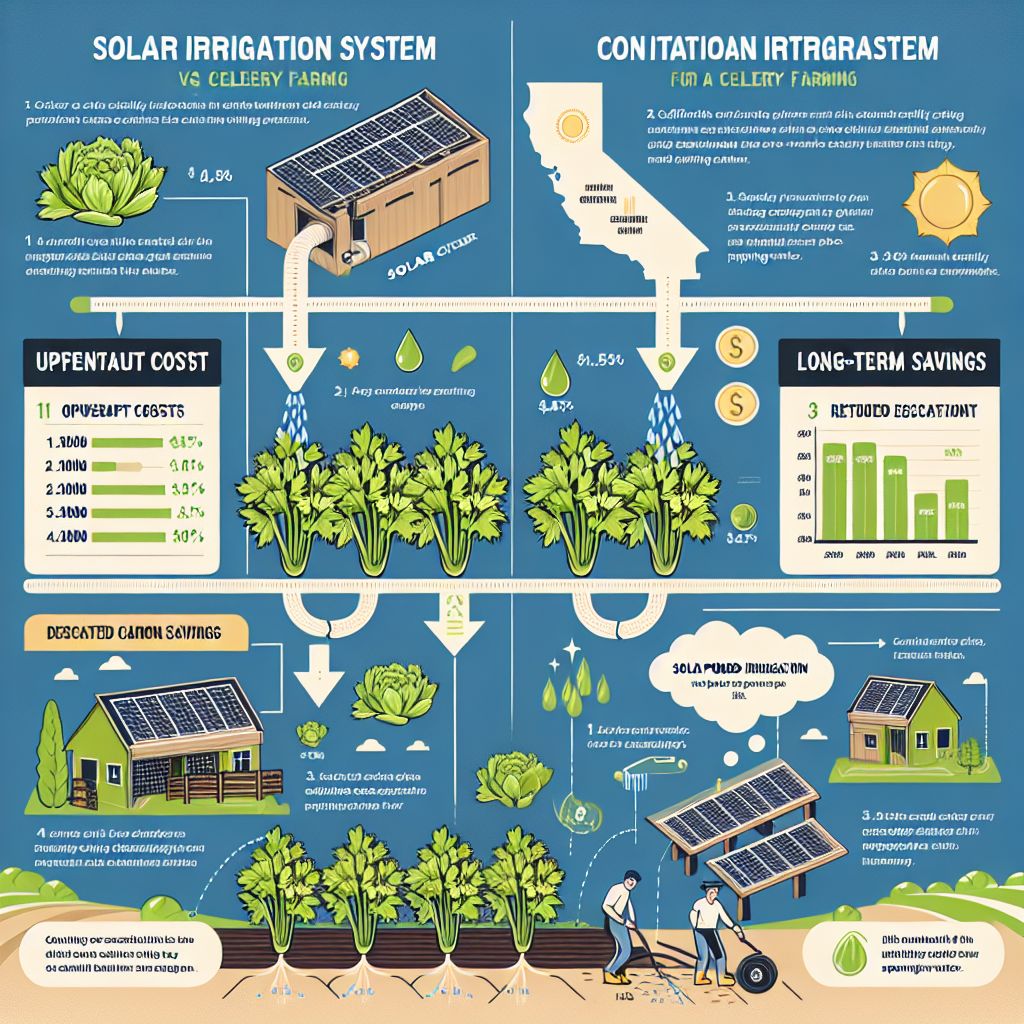
Price and Efficiency Comparison: Solar Irrigation Systems and Conventional Irrigation Systems for Celery Cultivation
Let’s get down to brass tacks. Conventional irrigation systems might seem more affordable at first glance, but they can end up costing you more in the long run due to their reliance on grid energy or fuel-powered generators. Solar irrigation systems, while more expensive to set up (mostly because of the solar panels and the cost of installing them), can save you a lot of money over time. After the initial setup, the energy they produce is completely free, which can lead to significant savings on operational costs.
Comparing Upfront Costs and Long-term Savings
Here’s the thing: while the initial cost of installing a solar irrigation system might be higher, typically ranging anywhere from a couple thousand to tens of thousands of dollars depending on the scale and complexity of your operation, the ongoing costs of running a traditional system can add up fast. Monthly electricity or fuel bills can take a big bite out of your bottom line.
Examples in Action: Real-life Implementations and Results
Consider a celery farm in California that transitioned to solar irrigation. The upfront cost was substantial, but the farm had saved enough on energy expenses within five years to pay for the setup. Now, they’re enjoying the perks of practically free irrigation, and they’ve also decreased their carbon emissions.
A small-scale organic celery grower provides a case study in the use of solar irrigation. After installing a small solar array to power a drip irrigation system, the grower was able to reduce water usage by 30% and completely eliminate electricity costs for pumping water. This case study shows that solar irrigation can be a viable option for even smaller operations.
These case studies show that although the initial cost of solar irrigation may be higher, the increased efficiency and cost savings over time can make it a financially savvy choice for celery growers.
There may be greater initial costs for solar irrigation, but these are counterbalanced by savings in the long run.
Conventional irrigation systems result in continuous monthly costs.
Examples from real life demonstrate substantial savings and smaller carbon footprints.
Here is a table comparing the cost and efficiency of an irrigation system with and without solar panels:
|
Aspect |
Without Solar Panels |
With Solar Panels |
|---|---|---|
|
Initial Cost | ||
|
Operating Cost |
Very low or zero fuel/electricity costs after installation. 1, 4 | |
|
Efficiency |
Depends on energy source efficiency. 4 |
Depends on solar radiation, temperature, system design. 1, 4 |
|
Environmental Impact |
Higher carbon footprint. 1 |
Lower carbon footprint, renewable energy. 1 |
|
Location Flexibility |
Limited to grid-connected or fuel access areas. 3 |
Can be used in remote off-grid areas. 3 |
|
Maintenance | ||
|
Lifespan |
Shorter for fuel-based systems. 1 | |
|
Long-term Costs |
Higher due to recurring fuel/electricity bills. 1 |
Lower total 20-year costs by 50-60% compared to traditional systems. 1 |
|
Government Incentives |
Generally none |
Many governments provide tax credits, subsidies for solar irrigation. 1 |
While solar irrigation systems have higher upfront costs, they can provide substantial long-term economic and environmental benefits over traditional irrigation systems powered by electricity grids or fossil fuels. 1, 3, 4
Having discussed the price and effectiveness of solar irrigation systems versus traditional systems, we can now explore the best combination of solar panels and irrigation systems for those who farm celery.
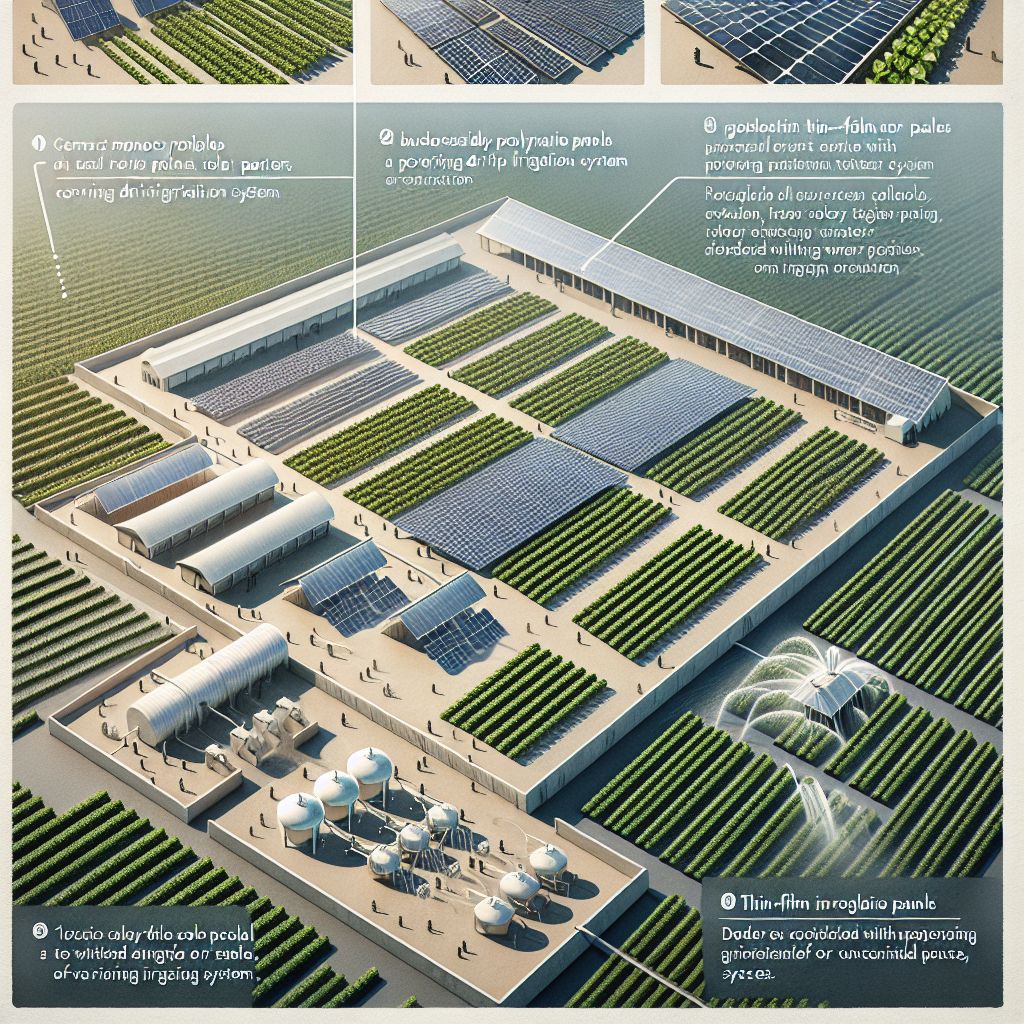
Which Solar Panels and Irrigation Systems are Best for Celery Farmers
For maximum efficiency, it’s important to pair the correct solar panels with the right irrigation system for your celery farm. Monocrystalline panels are a great choice for farms with limited space or for those who want to get the most out of their energy production. When combined with a drip irrigation system, you have a powerful combination that conserves both water and energy.
However, if you’re working with a limited budget, polycrystalline panels are still a good option. They can be used with any irrigation system, but for smooth and sustainable operation, drip irrigation is still the best choice. The important thing is to make sure your solar panels supply enough power for your pumps and that your irrigation system is as efficient as it can be.
Thin-film panels are also worth considering. They’re a good choice for unconventional spaces or surfaces that can’t support the weight of heavier panels. They can be used with any irrigation system, but keep in mind they’re not as efficient, so you might need more panels to achieve your goals.
For optimal results, combine high-efficiency monocrystalline panels with drip irrigation.
If you’re on a budget but still want efficiency, choose polycrystalline panels.
For unconventional spaces or surfaces, thin-film panels are the best choice.
Make sure your solar array can meet the energy demands of your irrigation system.
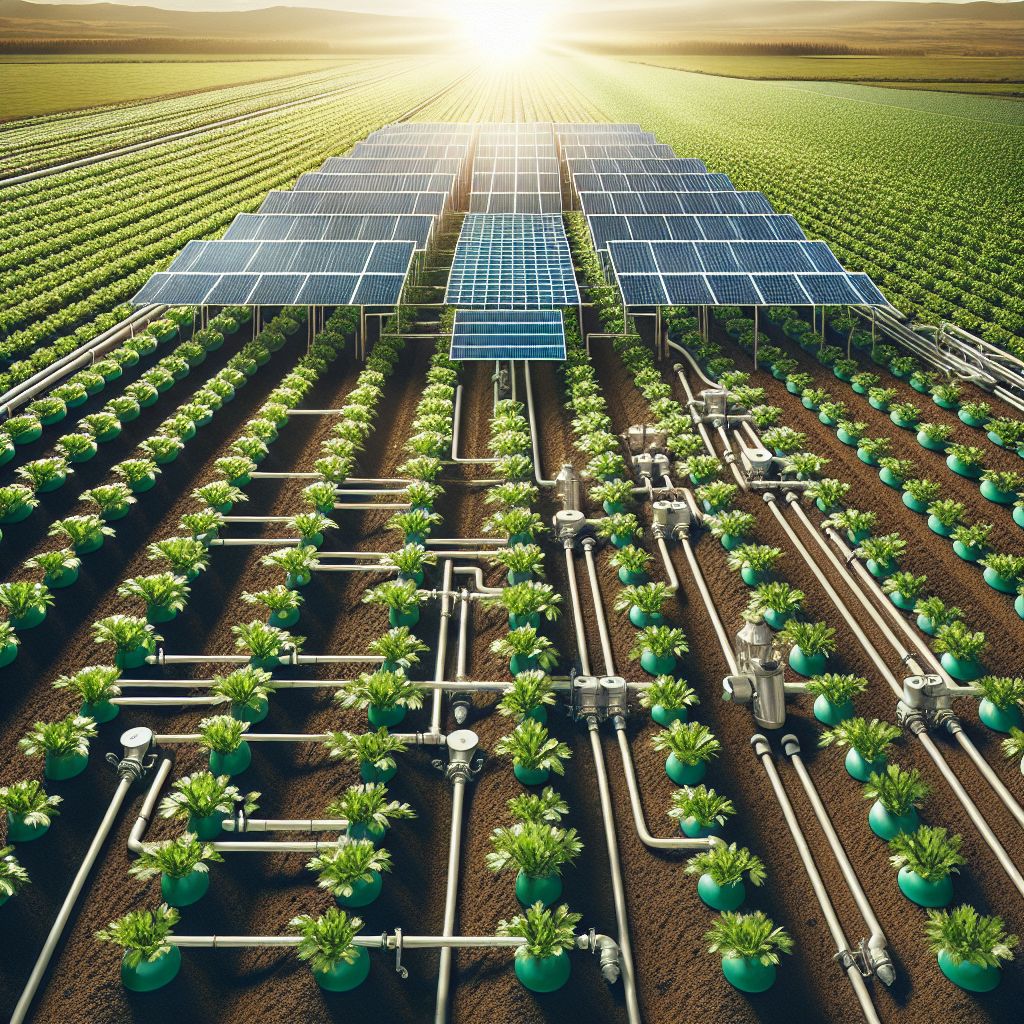
Conclusion: Is it a Smart Decision to Add Solar-Power to an Irrigation System for a Celery Farmer?
Let’s conclude. As a celery farmer, having an irrigation system is a must. It not only saves you time but also helps your crops grow better and can be a game-changer for your farm. But what about adding solar power? That’s when you’re stepping into the future of farming.
Using a solar-powered irrigation system doesn’t just mean you’re watering your plants. It means you’re committed to the environment and are ready to put your money where your mouth is. Plus, it’s cost-effective. After the initial investment, the sun takes over and does the rest of the work at no cost. It’s an intelligent decision for your wallet and the planet.
So, is it a good idea to incorporate solar power into your irrigation system? Without a doubt. It’s a commitment to the future of your farm, the well-being of the planet, and your own peace of mind. Transition to solar-powered irrigation and see your celery – and your savings – flourish.
Frequently Asked Questions:
What Is the Water Requirement for Celery and How Does Solar Irrigation Aid in This?
Celery is a crop that needs plenty of water and requires consistent moisture. Solar irrigation can help you provide the right amount of water to your celery without wasting any. Solar-powered drip irrigation systems can be set to water your crops at the best time of day, minimizing evaporation and maximizing the efficiency of water use.
Is Solar-Powered Irrigation Suitable for All Climates?
Solar-powered irrigation systems are adaptable and can be used in the majority of climates. Although they are most effective in sunny regions, contemporary solar panels can still collect energy even when it’s cloudy. Furthermore, battery storage systems can keep surplus energy for use when the sun is not out, guaranteeing your irrigation system operates efficiently regardless of the weather.
What Kind of Maintenance Do Solar-Powered Irrigation Systems Need?
Keeping up with maintenance is simple. Make sure your solar panels are clean and regularly check connections to make sure everything is running smoothly. Your irrigation system will need the standard maintenance: check for leaks, make sure emitters aren’t clogged, and replace any parts that are worn out. With the right care, your solar-powered irrigation system will keep your celery growing for many years.
Does the Government Provide Incentives for Solar-Powered Irrigation?
Indeed, they frequently do. Numerous governments provide incentives to farmers who implement renewable energy solutions. These incentives can take the form of tax credits, grants, or rebates, and can significantly reduce the initial cost of installing a solar-powered irrigation system. To find out what incentives are available in your area, check with your local and national agencies.
Does Solar-Powered Irrigation Work When It’s Cloudy or Raining?
Yes, it does. Solar panels are most efficient in direct sunlight, but they still produce power even when it’s cloudy, although not as much. And if you have a battery backup system, you can store energy for use when it’s raining. This means your irrigation system can continue to operate and provide your celery with the water it needs, regardless of the weather.







Leave a Reply